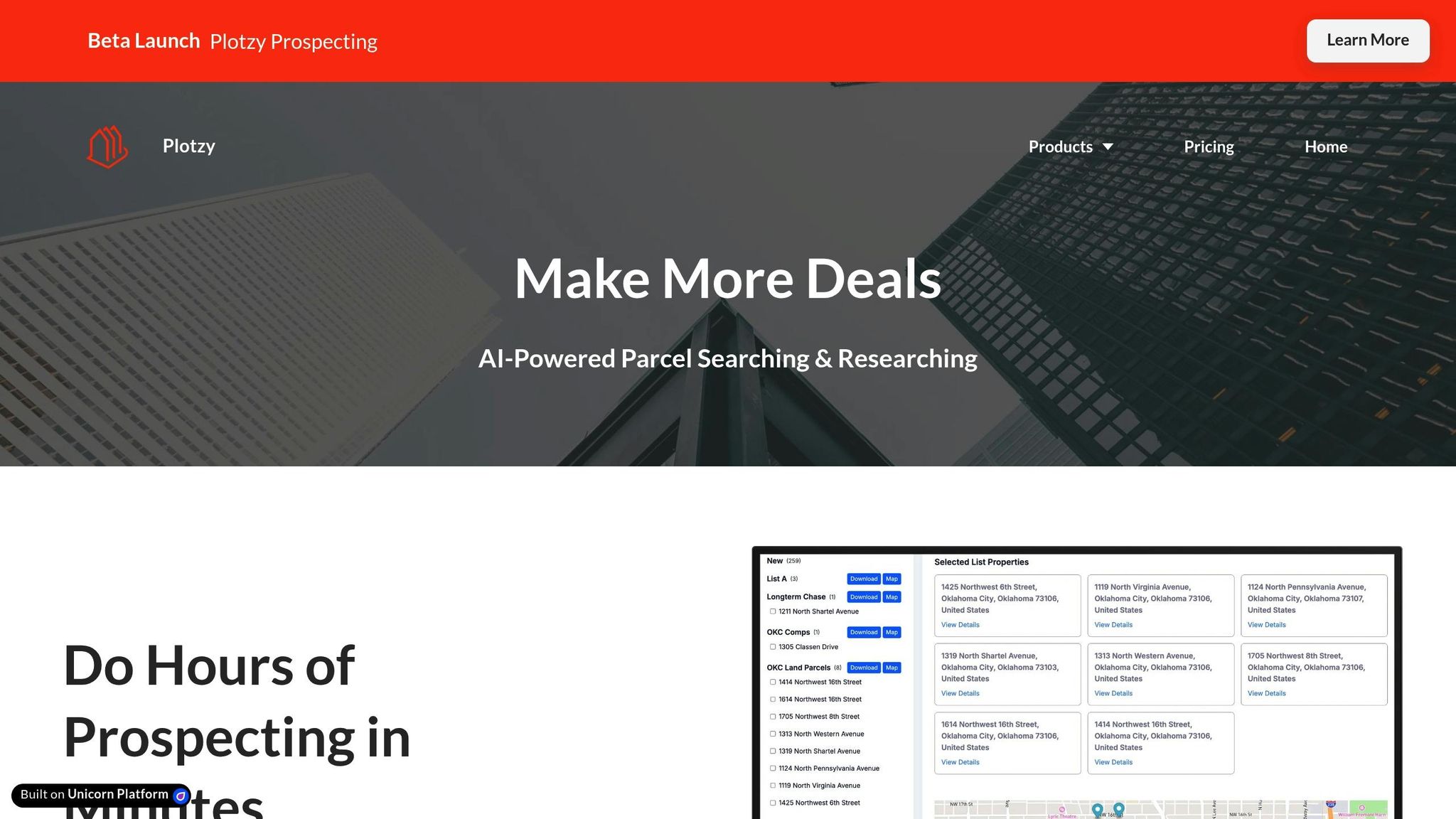Conditional Use Permits (CUPs) let property owners use land in ways that don't align with standard zoning rules, as long as specific conditions are met. They’re ideal when you want to use property for purposes like opening a business in a restricted area without fully rezoning it. Here's a quick breakdown:
- What They Are: CUPs allow specific uses under conditions to protect the community.
- When to Use: Needed for uses that may conflict with zoning rules, like a restaurant with live music in a residential area.
- How to Check: Research your property’s zoning classification using municipal maps and review local CUP rules.
- Approval Process: Submit detailed applications with site plans, impact studies, and fees. Address community concerns to improve approval chances.
- AI Tools: Platforms like Plotzy simplify zoning research and CUP applications by providing instant property reports and zoning data.
Quick Comparison:
| Tool/Permit Type | Purpose | When to Use |
|---|---|---|
| Conditional Use Permit | Allows specific uses with conditions | For uses that might affect nearby properties |
| Zoning Variance | Provides relief from zoning rules | When unique property features create hardships |
| Rezoning | Changes property’s zoning designation | For long-term, broader land use changes |
CUPs offer flexibility for property owners while safeguarding community interests. Use tools like Plotzy to streamline the process.
Zoning Laws & Conditional Use Permits for Commercial Real ...
How to Check CUP Requirements
Checking conditional use permit (CUP) requirements means diving into local zoning rules to see if your planned property use needs special approval.
Finding Property Zoning Info
Start by looking up your property's zoning designation. Many cities and towns provide online zoning maps and databases that make this process straightforward.
To find zoning details:
- Use your property's address or parcel number to search municipal zoning maps online.
- Check the zoning classification to see if your intended use is allowed, requires a CUP, or is prohibited.
| Use Type | Description | Example |
|---|---|---|
| Permitted | Allowed without special approval | Retail store in a commercial zone |
| Conditional | Needs CUP approval | Restaurant with live music |
| Prohibited | Not allowed | Industrial use in a residential zone |
Once you know the zoning classification, review your local CUP guidelines to see if your intended use aligns with local standards.
Understanding CUP Rules
Make sure your planned use meets the detailed standards set by your local zoning codes. These rules are what municipalities rely on when deciding whether to approve CUP applications.
Here are some factors cities often evaluate:
- How the proposed use affects public welfare
- Whether it could create nuisances
- Its alignment with the general plan
- Compatibility with current zoning
After reviewing these, look into any specific conditions that might apply to your intended use.
CUP Limits and Rules
CUPs come with restrictions to ensure the proposed use fits well with the surrounding area. These conditions vary depending on the jurisdiction.
Common restrictions include:
- Operating hours
- Noise limits
- Parking requirements
- Traffic control measures
- Landscaping rules
- Building modifications
It’s a good idea to consult with your local zoning supervisor. They can clarify the requirements, offer tips to improve your application's chances, and point out potential obstacles early on.
Keep in mind, CUPs can’t override zoning laws. They come with specific conditions to ensure your property use stays aligned with neighborhood standards.
Using AI Tools for CUP Research
AI-powered tools are transforming how professionals evaluate Conditional Use Permit (CUP) requirements by providing zoning data quickly and accurately. These tools enhance traditional methods, reducing research time and improving accuracy.
Quick Property and Zoning Searches
Tools like Plotzy allow users to search properties based on zoning criteria, filter parcels, access interactive maps, and instantly view property details. What once took weeks of manual effort can now be completed in seconds, thanks to automated analysis powered by AI.
Property Reports and Zoning Data
AI-generated property reports provide detailed information about zoning regulations and CUP requirements. These reports often include:
| Report Component | Information Provided |
|---|---|
| Zoning Classification | Current zoning designation and permitted uses |
| Use Restrictions | Specific limitations and conditions for the property |
| Development Standards | Details like height limits, setbacks, and density rules |
| Historical Data | Records of past zoning changes and CUP applications |
By compiling data from multiple municipal sources, these reports offer up-to-date information, helping real estate teams make informed decisions quickly and collaborate more effectively.
Time-Saving Features for Teams
AI tools enable instant report generation, real-time data sharing, and faster decision-making. This allows professionals to spend less time gathering data and more time analyzing it, streamlining the CUP application process and improving overall efficiency.
sbb-itb-11d231f
CUP Application Steps
Filing a Conditional Use Permit (CUP) application involves detailed preparation and can take several months to complete.
Filing Your CUP Application
Make sure to include all required components with accurate and detailed documentation:
| Required Component | Description |
|---|---|
| Application Forms | Fill out municipal forms with property details and the intended use |
| Site Plans | Provide drawings showing property layout, parking, and landscaping |
| Impact Studies | Submit traffic, noise, or other assessments if needed |
| Public Notice | Include documentation for notifying nearby property owners |
| Filing Fees | Pay the required municipal processing fees |
Assign a project coordinator to ensure everything is submitted correctly. Once your application is complete, focus on meeting the specific requirements for the CUP.
Meeting CUP Requirements
To get your CUP approved, you'll need to show that your plan meets local standards and addresses any community concerns. Here's what to focus on:
- Prove that your proposed use aligns with local development objectives and that infrastructure like parking and public services is sufficient.
- Resolve issues like traffic or noise with appropriate solutions.
- Highlight how your project will benefit the surrounding neighborhood.
If your application is denied, there are steps you can take to challenge the decision effectively.
Handling CUP Rejections
If your CUP application is rejected, work with a property attorney to review the reasons for denial and plan your appeal. Use these strategies to strengthen your case:
| Appeal Strategy | Action Steps |
|---|---|
| Legal Review | Work with an attorney to understand why the application was denied |
| Evidence Collection | Gather data to address concerns and support your position |
| Community Support | Show neighborhood backing and share examples of positive impact |
| Expert Testimony | Use professional assessments to strengthen your argument |
Conclusion
Why CUPs Matter
Conditional Use Permits (CUPs) allow property owners to use land in ways that go beyond standard zoning regulations, while still prioritizing the interests of the community. They make it possible to introduce uses like retail or manufacturing under controlled conditions, ensuring potential downsides are minimized. This approach becomes especially valuable as cities grow and land use becomes more diverse. CUPs strike a balance between flexibility for property owners and protections for the community - making them a key element in urban planning.
Benefits of Using Plotzy

Plotzy simplifies the often-complicated process of researching and analyzing CUPs with its AI-powered platform. Designed for real estate professionals, it helps users make better decisions while staying compliant with local zoning rules.
| Feature | How It Helps |
|---|---|
| Instant Zoning Lookup | Saves time by providing zoning details instantly. |
| Permitted Use Search | Quickly finds properties that meet specific needs. |
| Property Reports | Delivers detailed insights for CUP applications. |
| Parcel Filtering | Identifies properties that align with zoning criteria. |
With these tools, real estate teams can manage the entire CUP process more effectively - from research to submission - while ensuring they meet all zoning requirements. Plotzy turns a complex process into a streamlined, efficient workflow.
FAQs
What challenges can arise when applying for a Conditional Use Permit (CUP), and how can they be resolved?
Applying for a Conditional Use Permit (CUP) can present several challenges, such as meeting local zoning requirements, addressing concerns about potential impacts like increased traffic or noise, and ensuring the project aligns with the area's general development plan. These challenges can sometimes delay or complicate the approval process.
To address these issues, start by engaging with nearby residents and community groups early in the process to understand and address their concerns. Building community support can strengthen your application. Additionally, make sure your proposal complies with local zoning laws and demonstrates clear benefits to the community, such as economic growth or improved amenities. If environmental impacts are a concern, be prepared to conduct assessments or propose mitigation strategies to minimize any negative effects.
Taking a proactive, transparent approach and leveraging available tools to understand zoning and permit requirements can significantly improve your chances of success.
How does Plotzy use AI to simplify researching and applying for Conditional Use Permits?
Plotzy leverages AI-powered tools to streamline the process of researching and applying for Conditional Use Permits (CUPs). By analyzing zoning regulations, municipal databases, and property details, Plotzy helps you quickly identify whether a specific parcel or project requires a CUP and what conditions apply.
With Plotzy, you can save time by accessing clear, organized insights into local zoning requirements and land use policies. This allows you to make informed decisions and navigate the permitting process more efficiently, reducing delays and potential errors.
What can you do if your Conditional Use Permit application is denied, and how do you file an appeal?
If your Conditional Use Permit (CUP) application is denied, you may have the option to appeal the decision. Start by carefully reviewing the reasons for the denial, which are typically outlined in the decision notice. Consulting with a local property attorney who specializes in zoning and land use can help you understand your options and build a strong case for appeal.
To strengthen your appeal, gather evidence to address the concerns raised in the denial. This might include expert opinions, revised plans, or additional documentation showing how the project aligns with zoning regulations and community interests. Be sure to adhere to the deadlines and procedures outlined by the local municipality for filing appeals, as these vary by location. Taking a proactive and well-prepared approach can improve your chances of a successful outcome.


